Interchange (road)

In the field of road transport, an interchange is a road junction that typically uses grade separation, and one or more ramps, to permit traffic on at least one highway to pass through the junction without directly crossing any other traffic stream. It differs from a standard intersection, at which roads cross at grade. Interchanges are almost always used when at least one of the roads is a controlled-access highway (freeway or motorway) or a limited-access divided highway (expressway), though they may occasionally be used at junctions between two surface streets.
Terminology
Note: The descriptions of road junctions are for countries where vehicles drive on the right side of the road. For countries where driving is on the left the layout of the junctions is the same, only left/right is reversed.
- A freeway junction or highway interchange (in the U.S.) or motorway junction (in the UK) is a type of road junction, linking one motorway to another; to other roads; or sometimes to just a motorway service station. On the UK motorway network, most (but not all) junctions with other roads are numbered sequentially. In the U.S., interchanges are either numbered according to cardinal interchange number, or by mileage (typically the latter in most states).
- A highway ramp (as in exit ramp and entrance ramp) or slip road is a short section of road which allows vehicles to enter or exit a controlled-access highway (freeway or motorway).[1]
- A directional ramp always tends toward the desired direction of travel. This means that a ramp that makes a left turn exits from the left side of the roadway (a left exit). Left directional ramps are relatively uncommon as the left lane is usually reserved for high-speed through traffic. Ramps for a right turn are almost always right directional ramps. Where traffic drives on the left, these cases are reversed.[2]
- A non-directional ramp goes in a direction opposite to the desired direction of travel. Many loop ramps (as in a cloverleaf) are non-directional.[2]
- A semi-directional ramp exits a road in a direction opposite from the desired direction of travel, but then turns toward the desired direction of travel. Many flyover ramps (as in a stack) are semi-directional.[2]
- A U-turn ramp leaves the road in one driving direction, turns over or under it and rejoins in the opposite direction.

Weaving is an undesirable situation in which traffic veering right and traffic veering left must cross paths within a limited distance, to merge with traffic on the through lane.
The German Autobahn system splits Autobahn-to-Autobahn interchanges into two types: a four-way interchange, the Autobahnkreuz (AK), where 2 motorways cross, and a three-way interchange, the Autobahndreieck (AD) where two motorways merge.
Some on-ramps have a ramp meter, which is a dedicated ramp-only traffic light that throttles the flow of entering vehicles.
Complete and incomplete interchanges
A complete interchange has enough ramps to provide access from any direction of any road in the junction to any direction of any other road in the junction. A complete interchange between a freeway and another road (not a freeway) requires at least four ramps. Complete interchanges between two freeways generally have at least eight ramps, as having fewer would considerably reduce capacity and increase weaving. Using U-turns the number for two freeways can be reduced to six, by making cars that want to turn left either pass by the other road first, then make a U-turn and turn right, or turn right first and then make a U-turn. Depending on the interchange type and the connectivity offered other numbers of ramps may be used. For example, if a highway interchanges with a highway containing a collector/express system, additional ramps can be used to strictly link the interchanging highway with the collector and express lanes respectively. For highways with high-occupancy vehicle (HOV) lanes, ramps can be used to service these carriageways directly, thereby increasing the number of ramps used.
An incomplete interchange has at least one or more missing ramps that prevent access to at least one direction of another road in the junction from any other road in the junction. This is usually done so that users will have to pay toll if it is a tolled expressway.[citation needed]
System interchange
Four-way interchanges
Cloverleaf interchange

A cloverleaf interchange is typically a two-level, four-way interchange where all left turns are handled by loop ramps (right turns if traveling on the left). To go left, vehicles first cross over or under the targeted route, then bear right onto a sharply curved ramp that loops roughly 270 degrees, merging onto the interchanging road from the right, and crossing the route just departed.
The major advantage of cloverleafs is that they require only one bridge, which makes such junctions inexpensive as long as land is plentiful. A major shortcoming of cloverleafs, however, is weaving (see definition above), and the consequent low capacity of this design.
Cloverleafs also use a considerable area of land, and are more often found along older highways, in rural areas, and within cities with low population densities. A variant design is to separate all turning traffic into a parallel carriageway to minimize the problem of weaving. Collector and distributor roads are similar, but are usually separated from the main carriageway by a divider, such as a guard rail or Jersey barrier.
Stack interchange

A stack interchange is a four-way interchange whereby left turns are handled by semi-directional flyover/under ramps. To go left (right in countries with left-hand drive), vehicles first turn slightly right (on a right-turn off-ramp) to exit, then complete the turn via a ramp which crosses both highways, eventually merging with the right-turn on-ramp traffic from the opposite quadrant of the interchange. A stack interchange, then, has two pairs of left-turning ramps, of which can be stacked in various configurations above, below, or between the two interchanging highways.
Stacks do not suffer from the problem of weaving, and due to the semi-directional flyover ramps and directional ramps, they are generally safe and efficient at handling high traffic volumes in all directions.
A standard stack interchange includes roads on four levels, also known as a four-level stack. There are some five-level stacks, however these remain four-way interchanges, since the fifth level actually consists of dedicated ramps for HOV/bus lanes or frontage roads running through the interchange.
Stacks are significantly more expensive and land consuming than other four-way interchanges, and additionally may suffer from objections of local residents, because of their high visual impact. Large stacks with multiple levels may have a complex appearance and are often colloquially described as Mixing Bowls, Mixmasters (for a Sunbeam Products brand of electric kitchen mixers), or as Spaghetti Bowls or Spaghetti Junctions (being compared to boiled spaghetti).
Cloverstack interchange


Cloverstack interchanges are hybrid interchanges, using loopramps like cloverleafes to serve slower or less occupied traffic flow and flyover ramps like stack interchanges to serve faster and higher occupied traffic flow. If local and express ways serving the same directions and each roadway is connected righthand to the interchange, extra ramps are installed.
The cloverstack design is commonly used to upgrade cloverleaf interchanges to increase their capacity and eliminate weaving.
Turbine interchange



Another alternative to the four-level stack interchange is the turbine interchange (also known as a whirlpool). The turbine/whirlpool interchange requires fewer levels (usually two or three) while retaining semi-directional ramps throughout, and has its left-turning ramps sweep around the center of the interchange in a spiral pattern in right-hand traffic.
Turbine interchanges offer slightly less vehicle capacity because the ramps typically turn more often and change height quicker. They also require more land to construct than the typical four-level stack interchange.
In areas with rolling or mountainous terrain, turbine interchanges can take advantage of the natural topography of the land due to the constant change in the height of their ramps, and hence these are commonly used in these areas where conditions apply, reducing construction costs compared to turbine interchanges built on level ground.
Roundabout interchange

A further alternative found often is called a roundabout interchange. This is a normal roundabout except one (two-level) or both (three-level) mainlines pass under or over the whole interchange. The ramps of the interchanging highways meet at a roundabout or rotary on a separated level above, below, or in the middle of the two highways.
Roundabout interchanges are much more economical in use of materials and land than other interchange designs, as the junction does not normally require more than three bridges to be constructed. However, their capacity is limited when compared to other interchanges and can become congested easily with high traffic volumes.
Other/hybrid interchanges


Hybrid interchanges use a mixture of interchange types and are not uncommon. Their construction can consist of multiple interchange designs such as loop ramps, flyovers and roundabouts.
A windmill interchange is similar to a turbine interchange, but it has much sharper turns, reducing its size and capacity. A variation of the windmill, called the diverging windmill, increases capacity by altering the direction of traffic flow of the interchanging highways, making the connecting ramps much more direct. The interchange is named for its similar overhead appearance to the blades of a windmill.
Divided volleyball interchanges create a wide median between the carriageways of the two interchanging highways, using this space for connecting ramps.
Full diamond interchanges are large, multi-level interchanges that use flyover/under ramps to handle both right and left turns.
On interchanges with U-turns, to complete a left turn, traffic must either pass the interchange, make a U-turn and then exit right, or exit right first and then make a U-turn.
-

Windmill
-

Diverging windmill
-

Divided volleyball
-

Full diamond
-

U-turns
Three-way interchanges
Trumpet interchange


Trumpet interchanges have been used where one highway terminates at another highway. These involve at least one loop ramp connecting traffic either entering or leaving the terminating expressway with the far lanes of the continuous highway.
These interchanges are useful for highways as well as toll roads, as they concentrate all entering and exiting traffic into a single stretch of roadway, where toll booths can be installed. A double-trumpet interchange version can be found where a toll road meets another toll road or a free highway. They are also useful when most traffic on the terminating highway is going the same direction. The turn that isn't used often would get the slower loop ramp.
Trumpet interchanges are named as such due to their resemblance to trumpets. The bell of a trumpet can be seen where the terminating highway begins to interchange with the continuous highway, and the resemblance to the tubing is seen along the connecting loop ramps.
Directional T interchange

A full Y-interchange (also known as a directional T interchange) is typically used when a three-way interchange is required for two or three highways interchanging in semi-parallel/perpendicular directions, but it can also be used in right-angle case as well. Their connecting ramps can spur from either the right or left side of the highway, depending on the direction of travel and the angle.
Full Y-interchanges use flyover/flyunder ramps for both connecting and mainline segments, and they require a moderate amount of land and moderate costs since only two levels or roadway are typically used. They get their name due to their resemblance to the capital letter "Y", depending upon the angle from which the interchange is seen.
It features directional ramps (no loops, or weaving right to turn left) multilane ramps in comparatively little space. Some designs have two ramps and the "inside" thru road (on the same side as the freeway that ends) crossing each other at a three-level bridge. The disadvantage is that traffic of the terminating road enters and leaves on the passing lane.[3] The T interchange is preferred to a trumpet interchange because a trumpet requires a loop ramp by which speeds can be reduced, but flyover ramps can handle much faster speeds.
It is sometimes known as the "New England Y," as this design is often seen in the urban United States, especially the northeast,[3] as with the Braintree Split and the northern terminus of MA Route 24, both south of Boston.
Semi-directional T interchange


Like a directional T interchange, a semi-directional T interchange uses flyover/under ramps in all directions at a three-way interchange. However in a semi-directional T some of the splits and merges are switched to avoid ramps to and from the passing lane, eliminating the major disadvantage of the directional T. Semi-directional T interchanges are generally safe and efficient, though being three-level interchanges they do require more land and cost more than trumpets. Semi-directional T interchanges are built as two or three level stacks. Three level stacks may use an underpass and overpass at a single point. Two level stacks have a longer bridge or two shorter bridges on the same roadway.
Other/hybrid interchanges
Hybrid interchanges use a mixture of interchange types and are not uncommon. Their construction can consist of multiple interchange designs such as loop ramps and flyovers.
A half-clover interchange is essentially half a cloverleaf interchange, constructed to connect in just three directions instead of four. These are rarely used due to the traffic weaving that they cause and the large amount of land that they consume, but they can be built in areas where the connecting ramp along the loop of a trumpet interchange is not feasible due to building developments or physical limitations. Half-clovers are designed to be readily upgraded to full cloverleafs if the terminating highway is ever extended past the through highway.
A 3/4 volleyball interchange is a divided-volleyball interchange designed to meet at three points instead of four. Like the half-clover, it can easily be upgraded to a fully divided volleyball interchange if the terminating highway is extended beyond the through highway.
A T-bone interchange is essentially a compacted directional T interchange with sharper turns and a lower capacity, built when there is insufficient land or funds to build a directional T. Its two flyover/flyunder ramps contract together after passing over the through highway, but then they split into two segments, resembling the bone in a T-bone steak.
-

Half-clover
-

3/4-volley
-

T-bone
Two-way interchanges
A half trumpet interchange is essentially a trumpet interchange without its loop ramp and one of its directional ramps designed to meet the continuous highway in one direction, usually on a ninety degree or semi-perpendicular angle. Should the need arise, it can easily be constructed into a trumpet interchange, making it a three-way interchange.
A partial y interchange is used where one highway terminates at another highway with the same general directional alignment (usually a maximum of sixty degrees). The trunk of the terminating highway merges with the trunk of the continuous highway; vehicles traveling into the interchange may only exit traveling in the same direction. This type of interchange is often used for bypass routes, and is named for the shape the two highways' confluence makes when drawn on a map, creating a lower-case "y".
Hybrids, variations, and rare types also exist for two-way interchanges.

A basketweave interchange is commonly found on highways using a collector/express system or long collector/distributor lanes. In a basketweave, one highway is able to interchange with itself, allowing traffic traveling in the same direction to switch between carriageways through the use of flyover/under ramps created between two carriageways without causing weaving. These interchanges usually involve left exits and entry for the outer carriageway (right in left-hand drive) but can be configured to meet on the right.

Service interchange
Between a controlled- or limited-access highway and a road without access control
Diamond interchange


A diamond interchange is an interchange involving four ramps where they enter and leave the freeway at a small angle and meet the non-freeway at almost right angles. These ramps at the non-freeway can be controlled through stop signs, traffic signals, or turn ramps. Diamond interchanges are inexpensive to build and require little land but are prone to congestion and accidents if there is high traffic.

A dumbbell interchange is similar to the diamond interchange, but uses a pair of roundabouts to join the ramps with the non-highway. This typically increases the efficiency of the interchange when compared to a diamond.
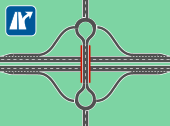
A dogbone interchange is similar to the dumbbell interchange except the roundabouts do not form a complete circle, instead having a "raindrop" or "teardrop" shape. If no other roads are connected to the roundabout, turnarrounds moves on the crossstreet would use the missing part of the roundabout, only.
Parclo interchange/folded diamond


A Parclo interchange, also known as a partial cloverleaf, is an interchange usually involving four to six ramps, two of which are loop ramps, which connect to the non-highway.
The parclo is a safer modification of the cloverleaf design. Depending on the number of ramps used, they take up a moderate to large amount of land and are typically inexpensive to build. Parclos with more ramps have a greater capacity and efficiency than parclos with fewer ramps. Parclos are sometimes called a folded diamond when only four ramps, in two quadrants, are used. If the loop ramps are constructed opposite or mirrored along the highway, weaving is avoided. Cloverleaf interchanges that involve a non-highway can be changed to parclos without too much reconstruction. Although the interchange's capacity is reduced, weaving is eliminated, increasing the safety and efficiency of the interchange.
Diverging diamond interchange
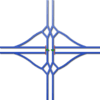
A diverging diamond interchange is similar to a traditional diamond interchange, except that it uses directional lanes for the non-highway to cross over each other on either side of the highway, altering the direction of travel on the crossstreet through the use of traffic lights. This allows all turns to and from the highway to be made without crossing the opposite direction of travel, increasing the capacity when compared to a typical diamond interchange.
The first one was built in France in the 1970s. Later, the same idea for the diverging diamond interchange came from a former shape of a freeway-to-freeway connection north of Baltimore, where I-695 has an interchange with Interstate 95. Whereas this interchange has been replaced with a four-level stack, it was once of a design known as the "synchronized split-phasing interchange".[4]
The first diverging diamond interchange in the United States opened on July 7, 2009, in Springfield, Missouri, at the junction of Interstate 44 and Missouri Route 13.[5]
Single-point urban interchange
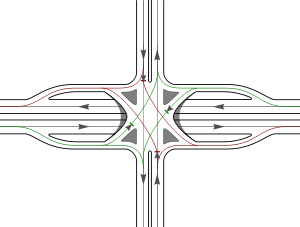

- The Single-point urban interchange, often abbreviated to SPUI, is a modification of the diamond interchange and has its ramps meet at one point, usually on the overpass/underpass of the non-highway. This requires only one set of traffic signals, increasing its efficiency and capacity when compared to a diamond.
Freeways in the Phoenix, Arizona metropolitan area are great examples of the utilization of SPUI interchanges. Some examples of SPUI are along Arizona State Route 51 from Downtown Phoenix all the way to Loop 101, another location where SPUI is common.
Since some SPUI interchanges have appeared in rural areas, such as U.S. Route 23 with M-59 (Michigan highway), the "urban" adjective started to become a misnomer for some areas.
Other/hybrid interchanges
Highway/non-highway hybrid interchanges consist of diamond and partial cloverleaf elements. Their construction can consist of multiple interchange designs such as loop ramps, flyovers, and roundabouts.
One form of the roundabout interchange can be used to connect a highway with a non-highway. It uses a single roundabout, rotary, or traffic circle which spans the highway as an over/underpass. Such junctions can be improved by adding a flyover for straight-through traffic on the non-freeway, creating the Roundabout interchange.
The three-level diamond interchange is three levels high, and it handles interchanging ramps via four intersections. This kind of an interchange can also be used to connect two highways together, but due to the use of intersections, its traffic is not free-flowing.
-
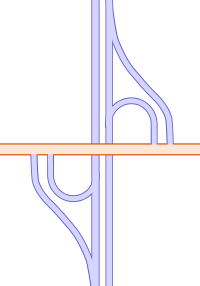
Four ramp partial cloverleaf (B-2)
-

Six ramp partial cloverleaf (A-4)
-
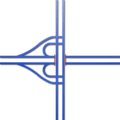
Folded diamond/parclo
-

Three level diamond
-

Roundabout
See also
References
- ↑ In the United Kingdom, "slip road" applies to any road section which allows traffic to feed into a lane of a highway
- ↑ 2.0 2.1 2.2 Iowa Department of Transportation (1995-09-01). "Cross Sections of One-Way Ramps and Loops" (PDF). Retrieved 2009-10-19.
- ↑ 3.0 3.1
- ↑ Chlewicki, Gilbert (2003). "New Interchange and Intersection Designs: The Synchronized Split-Phasing Intersection and the Diverging Diamond Interchange" (PDF). Retrieved 2009-10-20.
- ↑ Missouri Department of Transportation
External links
| Wikimedia Commons has media related to Interchanges. |
- Kurumi.com U.S. interchanges directory
- Glossary - Part of the publication Highway Design Handbook for Older Drivers and Pedestrians by the Turner-Fairbank Highway Research Center branch of the U.S. Federal Highway Administration
- Detailed history of interchanges with diagrams (German)
| ||||||||||||||||||||||||||||||||||||

